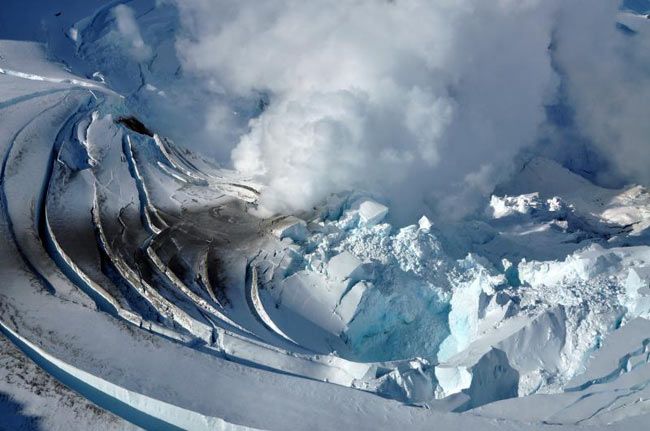Q&A: Will Redoubt Erupt Again?

Editor's Note: Redoubt erupted for a sixth time at 7:41 p.m. Alaska Daylight Time on Monday. Updated at 10:00 a.m. EDT March 24.
Alaska's Mount Redoubt volcano finally erupted a whopping five times after months of anticipation that it was on the verge of blowing its top. More eruptions could come today and in the coming days and weeks.
The interim between the initial eruption prediction in late January and this actual explosion illustrates how fickle volcanoes can be.
To clear things up, here are some facts about the Redoubt eruptions, including some answers from Janet Schaefer, a geologist with the Alaska Volcano Observatory (AVO).
How tall is Redoubt?
The volcano, which last erupted in 1989, rises to a height of 10,197 feet (3,108 meters) — or seven to seven and a half times the height of the Empire State Building. For comparison, Mount Rainier in Washington state is 14,411 feet tall. You can see Rainier from the Space Needle in Seattle.
Will Redoubt erupt again today?
Sign up for the Live Science daily newsletter now
Get the world’s most fascinating discoveries delivered straight to your inbox.
It's certainly possible, Schaefer said, especially given its eruption history.
When the volcano exploded in December 1989, it erupted intermittently for four months. AVO geologists are gearing up for a similar situation this time around, Schaefer told LiveScience.
So far, Redoubt has erupted five times, at 10:38 p.m. and 11:02 p.m. Alaska Daylight Time on Sunday, and 12:14 a.m., 1:39 a.m. and 4:31 a.m. Alaska Daylight Time on Monday, according to the AVO.
Why did it take so long for the volcano to erupt?
"That the million dollar question," Schaefer said. "There's a lot of data analysis to be done."
Schaefer said that geologists will have to wait to get their hands on the ash, rocks, lava and other materials spewed out by Redoubt before they can paint an accurate picture of the inner-workings that led to the explosion.
Examining the mineralogy and chemical contents of these materials can tell scientists what depth below the Earth's surface they came from, how long it took them to push their way to the surface and other key clues. Matching this information with the seismic record will help them better understand how the volcanic event evolved.
Part of the difficulty in predicting this eruption is the lack of telemetry and GPS systems on the volcano, which can give a real-time picture of what's happening with the volcano, Schaefer said.
Will Redoubt get these systems with some of the stimulus money slated for volcano monitoring?
No final decision has been made yet, but Redoubt would be "a fantastic candidate," Schaefer said.
Was there any lava or other pyroclastic materials in the eruption?
Geologists likely won't be able to tell until later in the morning, Schaefer said. "We'll have to wait until the smoke clear."
There was some lava in the 1989 eruption, which featured a dome-building episode in the crater of the volcano after the initial eruption.
"It's certainly injecting ash high into the atmosphere," she added. The AVO Web site reports that the ash was vaulted 15,000 feet above sea level.
Some light ashfall has already been reported, and more will likely come once people in the area begin to wake up.
While the 1989 eruption spewed considerable amounts of ash in and around Anchorage, this eruption will likely yield a minor amount. "We're not expecting a large amount of ash," Schaefer said.
There were issues with the ash affecting flights in the area in the last eruption. Have warnings been sent out this time?
"The FAA [Federal Aviation Administration] is the very first number on our call-down list," Schaefer said. She said there had already been some cancellations and diversions of flights in the area.
When did the latest concerns about Redoubt heat up?
AVO scientists began predicting that Redoubt, located 106 miles (170 km) southwest of Anchorage in the Aleutian Islands, was headed for an imminent eruption after the volcano began to show signs of increased seismic rumblings in late January.
{{ video="LS_090323_Redoubt" title="The Restive Redoubt Volcano in Alaska" caption="The redoubt volcano, which erupted overnight March 22-23, 2009, is seen here on Feb. 7, 2009" }}
- Video - The Restive Redoubt Volcano in Alaska
- Volcano News, Images and Information
- Volcano Quiz Part 1, Part 2

Andrea Thompson is an associate editor at Scientific American, where she covers sustainability, energy and the environment. Prior to that, she was a senior writer covering climate science at Climate Central and a reporter and editor at Live Science, where she primarily covered Earth science and the environment. She holds a graduate degree in science health and environmental reporting from New York University, as well as a bachelor of science and and masters of science in atmospheric chemistry from the Georgia Institute of Technology.











